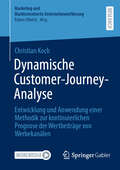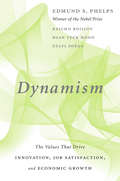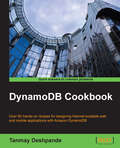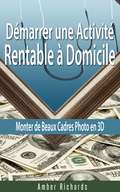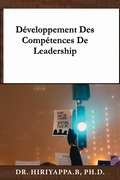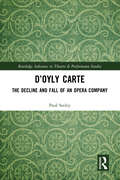- Table View
- List View
Dynamics, Silviculture and Management of Mixed Forests (Managing Forest Ecosystems #31)
by Hans Pretzsch Andrés Bravo-Oviedo Miren Del RíoThe capacity of mixed forests to mitigate climate change effects by increasing resilience and lowering risks is pinpointed as an opportunity to highlight the role of tree species rich forests as part of complex socio-ecological systems. This book updates and presents the state-of-the-art of mixed forest performance in terms of regeneration, growth, yield and delivery of ecosystem services. Examples from more than 20 countries in Europe, North Africa and South America provide insights on the interplay between structure and functionining, stability, silviculture and optimization of management of this type of forests. The book also analyses the role of natural mixed forests and mixed plantations in the delivery of ecosystem services and the best modelling strategy to study mixed forest dynamics. The book is intended to serve as a reference tool for students, researchers and professionals concerned about the management of mixed forests in a context of social and environmental change.
Dynamique De Groupe Et Création D'équipe: Un Manuel
by Hiriyappa BAvez-vous déjà demandé ce qu'il faut pour devenir un professionnel accompli ? Ce livre vous prend par le poignet et vous guide vers le succès. Il renforce le fait qu'une équipe est toujours plus maligne que les solitaires. La méthodologie heuristique suivie dans ce livre, simple et facile à suivre, vous permet de vous y référer à tout moment. Les idées sont présentées sous forme de liste pour en faciliter la lecture. Ayez une carrière réussie.
Dynamische Ambidextrie durch interdependente Routinen: Einfluss und Auswirkung von Scrum auf Projektebene (Zukunftsfähige Unternehmensführung in Forschung und Praxis)
by Patrick SailerIn diesem Buch wird die dynamische Entwicklung von Ambidextrie in Projekten durch interdependente Routinen auf fundiert-theoretischer sowie feingranular-empirischer Basis konzipiert. Um bisherige Schwachstellen der Forschung zu Ambidextrie in Projekten zu beseitigen, zeigt Patrick Sailer die Wirkung von Scrum als eine agile Vorgehensweise auf die Entwicklung von Ambidextrie auf. Damit liefert der Autor wichtige theoretische Beiträge in den Bereichen Ambidextrie, Routinen und Projektmanagement.
Dynamische Customer-Journey-Analyse: Entwicklung und Anwendung einer Methodik zur kontinuierlichen Prognose der Wertbeiträge von Werbekanälen (Marketing und Marktorientierte Unternehmensführung)
by Christian KochIn dem vorliegenden Buch wird eine neuartige Methodik zur kontinuierlichen Prognose der Wertbeiträge von Werbekanälen im Rahmen von Mehrkanalstrategien präsentiert und auf Basis eines umfangreichen Datensatzes aus über 49.000 realen Customer Journeys getestet. Durch eine dynamische Verarbeitung von Customer-Journey-Daten und die Variation von Datenerhebungszeiträumen können Werbetreibende die zukünftigen Wertbeiträge von Werbekanälen genauer prognostizieren und ihre Werbebudgets zielgerichteter einsetzen. Neben den in Rahmen dieses Werkes verwendeten Markov-Graphen kann die entwickelte Methodik auch auf zahlreiche weitere Attributionsmodelle und Untersuchungsgegenstände angewendet werden. Dies macht sie sowohl für die akademische Forschung als auch für praktische Anwendungen äußerst relevant.
Dynamische Disposition
by Timm GudehusDie dynamische Disposition ermöglicht marktgerechte Lieferzeiten und kostenoptimale Lieferfähigkeit, sie verhindert überhöhte oder unzureichende Bestände. In dem Buch werden Strategien, Algorithmen und Verfahren der dynamischen Auftrags-, Bestands- und Fertigungsdisposition allgemein verständlich beschrieben und anhand von Beispielen demonstriert. Mithilfe des Regelwerks kann die dynamische Disposition in allen Branchen organisiert und implementiert werden. Die erweiterte 3. Auflage zeigt Potenziale für Serviceverbesserung und Kosteneinsparung auf.
Dynamische Kapazitätssteuerung bei kundenindividueller Auftragsproduktion in der stahlverarbeitenden Industrie
by André HintschesHersteller kundenindividueller Erzeugnisse sehen sich einerseits mit einer Vielzahl volatiler Kundenaufträge und andererseits einem weitgehend inflexiblen Kapazitätsangebot in Produktions-netzwerken konfrontiert. Aus diesem Spannungsfeld erwächst die Notwendigkeit, die betriebs-wirtschaftliche Vorteilhaftigkeit von Kundenaufträgen im Kontext einer unsicheren, zukünftigen Auftragslage zu ermitteln und bei der Auftragsannahme geeignet zu berücksichtigen. André Hintsches führt vor dem Hintergrund zahlreicher Unsicherheitstreiber eine Systematik zur dynamischen Berechnung von Bid-Preisen ein. Hieraus entwickelt er ein Verfahren zur dynamischen Kapazitätssteuerung bei kundenindividueller Auftragsproduktion und greift damit einen Themenkomplex auf, der von hoher praktischer Bedeutung und Aktualität gekennzeichnet ist.
Dynamische Makroökonomik
by Maik HeinemannDas Lehrbuch behandelt die dynamische makrökonomische Theorie im geschlossenen Modellrahmen des Ramsey-Modells. Mit der Wachstums-, Konjunktur- und Geldtheorie werden die Hauptgebiete der Makroökonomik behandelt. Zusätzlich werden aber auch Verteilungsaspekte berücksichtigt. Exemplarisch wird gezeigt, wie sich die dynamische makrökonomische Theorie zur quantitativen Analyse wirtschaftspolitischer Fragestellungen und auch zur Untersuchung der Verteilungswirkungen wirtschaftspolitischer Maßnahmen nutzen lässt. Das Buch gibt einen Einblick in die Methoden, die in der dynamischen Makroökonomik zur Anwendung kommen und bietet damit die Grundlage für eine vertiefende Auseinandersetzung mit den einzelnen Themengebieten.
Dynamische Mitarbeiterführung: Achtsam und flexibel Führungssituationen meistern (essentials)
by Marco FurtnerMarco Furtner beschreibt in diesem essential einen integrativen Führungsansatz, welcher die Vorzüge verschiedener Arten von Führungsverhalten für unterschiedliche Führungssituationen aufzeigt. Die jeweilige situative Angemessenheit von direktivem, kontrollierendem, aversivem, transaktionalem, transformationalem und ermächtigendem Führungsverhalten wird beschrieben und mit praktischen Beispielen belegt. Zudem werden mit der passiven und Laissez-faire-Führung zwei sehr ineffektive Formen von Führungsverhalten dargelegt. Eine achtsame Führungskraft ist sich ihrer selbst, ihrer Umwelt und der jeweiligen Führungssituation bewusst. Sie verfügt über ein breites Verhaltensspektrum, welches flexibel und dynamisch an bestimmte Führungssituationen angepasst werden kann.
Dynamisches Change Management: Ein kontext-orientierter Ansatz zur Unterstützung der Anpassungsfähigkeit von Organisationen
by Martin Kupiek Bettina MarcinkowskiDas Buch stellt einen kontext-orientierten, dynamischen Ansatz für komplexe Veränderungsprojekte in Organisationen vor. Die Herausgeber zeigen anhand der soziologischen Systemtheorie einen Referenzrahmen auf, der nicht nur die klassischen Aspekte der Veränderungstheorie thematisiert, sondern auch das Zusammenspiel von formaler und informeller Ebene sowie der Schauseite (Außenwirkung) von Organisationen verdeutlicht. Eine Referenz an die Theaterwissenschaften – „wenn Luhmann auf Shakespeare trifft“ – verdeutlicht die Eigenarten in der Kommunikation nach außen. Das organisationale Change Management bezieht sich dabei nicht nur auf die Strategien und deren Umsetzung, sondern berücksichtigt vor allem den schnellen Anpassungsbedarf in Organisationen. Ausgehend von der Organisationstheorie werden sowohl die formalen als auch die informalen Aspekte der Struktur und der Kultur einer Organisation in den Vordergrund gestellt und die emotionale Seite des Wandels betont. Zusätzlich zur Emotionstheorie werden in den Beiträgen das strategische Management, Kommunikation, Human Resource Management und die Außenwirkungen der Organisation thematisiert. Das Buch ist ein Hilfsmittel für jeden, der ein Veränderungsprojekt leitet oder die Anpassungsfähigkeit des Unternehmens unterstützen möchte.
Dynamism: The Values That Drive Innovation, Job Satisfaction, and Economic Growth
by Edmund S. Phelps Gylfi Zoega Raicho Bojilov Hian Teck HoonNobel Laureate Edmund Phelps and an international group of economists argue that economic health depends on the widespread presence of certain values, in particular individualism and self-expression. Nobel Laureate Edmund Phelps has long argued that the high level of innovation in the lead nations of the West was never a result of scientific discoveries plus entrepreneurship, as Schumpeter thought. Rather, modern values—particularly the individualism, vitalism, and self-expression prevailing among the people—fueled the dynamism needed for widespread, indigenous innovation. Yet finding links between nations’ values and their dynamism was a daunting task. Now, in Dynamism, Phelps and a trio of coauthors take it on. Phelps, Raicho Bojilov, Hian Teck Hoon, and Gylfi Zoega find evidence that differences in nations’ values matter—and quite a lot. It is no accident that the most innovative countries in the West were rich in values fueling dynamism. Nor is it an accident that economic dynamism in the United States, Britain, and France has suffered as state-centered and communitarian values have moved to the fore. The authors lay out their argument in three parts. In the first two, they extract from productivity data time series on indigenous innovation, then test the thesis on the link between values and innovation to find which values are positively and which are negatively linked. In the third part, they consider the effects of robots on innovation and wages, arguing that, even though many workers may be replaced rather than helped by robots, the long-term effects may be better than we have feared. Itself a significant display of creativity and innovation, Dynamism will stand as a key statement of the cultural preconditions for a healthy society and rewarding work.
DynamoDB Cookbook
by Tanmay DeshpandeOver 90 hands-on recipes to design Internet scalable web and mobile applications with Amazon DynamoDB About This Book * Construct top-notch mobile and web applications with the Internet scalable NoSQL database and host it on cloud * Integrate your applications with other AWS services like AWS EMR, AWS S3, AWS Redshift, and AWS CloudSearch etc. in order to achieve a one-stop application stack * Step-by-step implementation guide that provides real-world use with hands-on recipes Who This Book Is For This book is intended for those who have a basic understanding of AWS services and want to take their knowledge to the next level by getting their hands dirty with coding recipes in DynamoDB. What You Will Learn * Design DynamoDB tables to achieve high read and write throughput * Discover best practices like caching, exponential back-offs and auto-retries, storing large items in AWS S3, storing compressed data etc. * Effectively use DynamoDB Local in order to make your development smooth and cost effective * Implement cost effective best practices to reduce the burden of DynamoDB charges * Create and maintain secondary indexes to support improved data access * Integrate various other AWS services like AWS EMR, AWS CloudSearch, AWS Pipeline etc. with DynamoDB In Detail AWS DynamoDB is an excellent example of a production-ready NoSQL database. In recent years, DynamoDB has been able to attract many customers because of its features like high-availability, reliability and infinite scalability. DynamoDB can be easily integrated with massive data crunching tools like Hadoop /EMR, which is an essential part of this data-driven world and hence it is widely accepted. The cost and time-efficient design makes DynamoDB stand out amongst its peers. The design of DynamoDB is so neat and clean that it has inspired many NoSQL databases to simply follow it. This book will get your hands on some engineering best practices DynamoDB engineers use, which can be used in your day-to-day life to build robust and scalable applications. You will start by operating with DynamoDB tables and learn to manipulate items and manage indexes. You will also discover how to easily integrate applications with other AWS services like EMR, S3, CloudSearch, RedShift etc. A couple of chapters talk in detail about how to use DynamoDB as a backend database and hosting it on AWS ElasticBean. This book will also focus on security measures of DynamoDB as well by providing techniques on data encryption, masking etc. By the end of the book you'll be adroit in designing web and mobile applications using DynamoDB and host it on cloud. Style and approach An easy-to-follow guide, full of real-world examples, which takes you through the world of DynamoDB following a step-by-step, problem-solution based approach.
Dynashears, Inc.
by Thomas R. PiperA senior loan officer is reviewing the recent performance of a company that has failed to repay its loan as scheduled. The failure results from a cyclical downturn in sales, coupled with a lag in cutting back production. Inventory risk is minimal. Teaching objective: Practice in financial analysis and in understanding the impact of business cycle on durable goods companies. Also an opportunity to evaluate the situation from a lender's perspective. A rewritten version of an earlier case.
Dynatrol Corp.: Andover Assembly Division
by Janice H. Hammond H. Kent Bowen Ramchandran JaikumarWhile grappling with glitches in the design and operation of its production system, Andover Assembly must also launch a new sensor product line to meet ultimatums issued by frustrated Signatron vice presidents. The financial returns of the division are not meeting corporate's expectations and plant manager Jan Havel has been sent in to turn around the plant's operations under 2 (6- and 12-month) deadlines. To turn the unhappy customers into cooperating customers, the Andover division is faced with the challenge of reaching nearly 100% ontime delivery performance within weeks. The introduction of the new product line, which requires some of the same resources, compounds the team's problems.
Dynatronics, Inc.
by William E. FruhanThe student must determine the financing requirements posed by growth, change of inventory policy, and introduction of new product and then select the best method of financing them. Has been used as a four-hour exam. A revised and updated version of an earlier case by L.E. Thompson and V.L. Andrews.
Dysfunction and Deviance Across Family Firms: Varying Reflections of the Dark Side (Palgrave Studies in Family Business Heterogeneity)
by Roland E. KidwellThis book considers the differential occurrence and impact of deviance and dysfunction on family firms. The author argues that how family systems develop in family, cultural, and societal contexts, strongly affects differences in the types and levels of negative behaviours in family firms. By considering the context of recent developments and extensions in family systems theory, this book will guide future research investigating the impact of broader definitions of family to consider socio-legal, social-biological, and role-based families. It provides a retrospective look that lays the groundwork for a future research agenda that can blend and develop current management theory as it relates to family firms with the latest developments in family systems theory.
Dysfunction: Canada after Keystone XL
by Dennis Mcconaghy#1 Calgary Herald Bestseller An investigation of the history and demise of the most controversial North American energy infrastructure project. In 2015, President Barack Obama denied approval for TransCanada’s Keystone XL pipeline, which would have carried crude oil from the Canadian oil sands to the U.S. Gulf Coast, providing great economic benefit to Canada. Over seven years of regulatory process, environmental activism, and media attention, the project had become infamous, a cause célèbre for North America’s ENGO movement and a test of Obama’s bona fides in the face of global climate change risk. As one of TransCanada’s senior executive group, Dennis McConaghy provides an insider’s perspective of Keystone XL’s history and demise. How did this routine infrastructure acquire iconic status? Why couldn’t government and industry find some accommodation to salvage the project? And most importantly, what must Canada learn from Keystone XL’s demise? Can the country find common ground between economic value and credible carbon policy?
Dysfunctions of the Welfare State: Dysfunctions Of The Welfare State
by Joel GibbonsThis timely analysis of today's economic realities relates the headlines to the long term causes from which they spring. Why did we have a worldwide financial crisis in 2008? Is stimulus the answer, and what are its risks and potential returns? Why are our investments so unprofitable? Why are our citizens struggling to find work? Why do we repeatedly confuse effort with results? The author finds the answers to these questions in the dysfunctions of the welfare state.Economics is the science of the creation and exchange of value, but Gross Domestic Product (GDP) confuses value with the creation and exchange of "goods and services." Along the way, GDP has become a measure not of value created, but of effort expended and of costs incurred. This confusion has become the cornerstone of policy manipulation of "the economy," because it is very easy to incur costs, though not so easy to create value. Policymakers are not eager to correct this discrepancy because it is easier to manufacture costs through brute force than to produce results that have real value.This book pins down the major contributors to these distortions in a number of specific areas, including education, science and engineering, hospitals and other medical facilities, the public utility transmission grids, and in the trade deficit. It also pursues the distortions caused by short-sighted public policy in the capital markets. The book concludes with a discussion of market efficiency and inefficiency leading to the conclusion that policy intervention into the capital markets reduces their capacity to allocate capital productively. The author addresses this broad topic from the unique perspective of someone who has contributed both to the theoretical analysis and to the actual practice of markets.
Dystopia and Economics: A Guide to Surviving Everything from the Apocalypse to Zombies (Routledge Economics and Popular Culture Series)
by Charity-Joy Revere Acchiardo Michelle Albert VachrisGovernment collapsing? Zombies hunting you down? Everyone you know killed by a global epidemic? Not to worry! Economics holds the keys to survival. Often known as "the dismal science", it is particularly equipped to reveal order in what seems like chaos. Economists observe human behaviour: what leads us to take action, and the subsequent consequences. However, the choices made by individuals are not made in isolation; they influence and are influenced by the actions of others. A set of rules, even if unwritten, guides human behaviour. Foundational economic principles stand firmly in place, even when society is breaking down, and an understanding of these basic tenets of societies is essential to surviving the end of the world as we know it. In this book, the authors draw from popular culture to show economic principles at work in the dystopian societies depicted in The Walking Dead, Mad Max: Fury Road, The Hunger Games, Divergent, A Clockwork Orange, and Last Man on Earth. In each society, its members face resource and social constraints that incentivize particular behaviours and lead to predictable outcomes. How does human behaviour change when resources are severely limited, the legal system breaks down, or individual freedom is stifled? The examples presented here shed an eerie light on the principles that guide our actions every day. Dystopia and Economics: A Guide to Surviving Everything from the Apocalypse to Zombies provides a user-friendly introduction to economics suitable for a general audience as well as devoted students of the discipline.
Débuter une entreprise de nettoyage résidentiel
by Amber Richards Avinash MayaramAvez-vous déjà pensé à débuter votre propre entreprise de nettoyage résidentiel ? Avez-vous souhaité un calendrier flexible, de devenir votre propre patron et gagner un bon revenu en même temps ? Dans Débuter une entreprise de nettoyage résidentiel, l’auteur Amber Richards a été propriétaire et a géré une entreprise de nettoyage résidentiel pendant trois ans. Elle révèle des astuces et conseils qu’elle aurait aimé savoir avant de démarrer l’entreprise. Avec de la transparence par rapport aux erreurs et aux réussites, ce livre est rempli d’informations et de stratégies d’une initiée qui a vraiment travaillé dans le domaine. L’accent n’est pas mis sur les astuces pratiques de nettoyage, même s’il y a un chapitre concernant d’excellents produits en général. Les services de nettoyage sont en grande demande à cause de la vie mouvementée d’aujourd’hui, et peuvent être très profitables. Vous n’avez pas à effectuer le nettoyage physique vous-même, si ce n’est pas ce que vous voulez. Une option viable est de créer un service de nettoyage et d’embaucher des employés pour effectuer le travail physique. C’est parfait pour une personne envisageant de débuter un service de nettoyage résidentiel, ou qui est simplement curieuse, et pour une personne déjà établie, mais qui souhaite agrandir son entreprise. Ce livre offre de nombreuses idées créatives pour déterminer exactement la direction que vous souhaitez prendre dans votre entreprise, des idées de marketing, et offre des sessions de réflexion originale pour vous aider à faire prospérer l’entreprise de nettoyage résidentiel de vos rêves.
Démarrer une Activité Rentable à Domicile
by Amber Richards Giovanni PantanoCet livre décrit les aspects importants à retenir pour celui qui souhaiterait démarrer une activité à domicile dont la spécialité est de réaliser de beaux cadres photo en3D. Il examine les différentes options possibles, allant du simple hobby, de l’activité à domicile jusqu’au magasin avec pignon sur rue. Il aborde aussi les aspects de conception, réalisation et de commercialisation. Toutefois, ce livre n’a pas pour objectif d’examiner les aspects fiscaux, quels qu’ils soient, l'obtention d’un capital de départ, l’apport de conseils juridiques ou comptables, une étude de marché et la création d'un plan d'affaires.
Détente et Réduction du Stress
by James ChristiansenÊtes-vous stressé et dépassé par la vie ? Vous avez du mal à faire face à tout ce que vous devez faire ? Il est temps d'apprendre à se détendre et à réduire le stress dès aujourd'hui ! Soyons réalistes : le stress est partout autour de nous. La vie moderne est remplie de situations stressantes et nous sommes presque tous affectés par le stress à un moment ou à un autre de manière négative. Malheureusement, de nombreuses personnes cherchent à réduire leur stress en adoptant des habitudes malsaines, telles que la suralimentation ou l'abus de drogues et d'alcool. Il existe certainement des médicaments qui peuvent aider à soulager un stress grave, mais qu'en est-il des remèdes naturels, holistiques et non médicinaux pour le stress ? C'est là que ce livre vous aidera : Ce livre vous montrera les meilleures méthodes sans drogue pour vous apprendre à gérer le stress, qui intègrent toutes les énergies naturelles et les propriétés curatives de votre corps. Quelle meilleure façon de combattre le stress qu'en le combattant avec vos propres capacités et ressources naturelles ? Vous découvrirez comment ces techniques peuvent vous aider à vaincre le stress : - Acupuncture - Massothérapie - Yoga - Des rires, et plus encore ! En outre, le livre contient des liens permettant de trouver des praticiens certifiés de ces thérapies ainsi que des ressources supplémentaires utiles. Si vous souffrez de stress et que vous cherchez des solutions, ne cherchez plus. Vous devez apprendre à soulager votre stress, et cela commence par la lecture de ce livre. Ce livre vous apportera des réponses sur les techniques qui peuvent vous aider à vaincre le stress dans votre vie pour toujours !
Développement des compétences de leadership
by Hiriyappa BCe livre met les apprenants dans un univers de développement des compétences de leadership, en appliquant efficacement les fonctions de leadership dans tous les domaines de leur vie. Ce livre donne aux apprenants une feuille de route claire à travers le développement des compétences de leadership. Les apprenants peuvent ainsi percevoir leur statut et leur position actuelle, et ainsi de former un plan pour développer leurs compétences de leadership. Ce livre présente un plan de développement efficace des compétences de leadership et peut vous aider à améliorer vos compétences de leadership. Ce livre précise que vous devez devenir un leader.
D’Oyly Carte: The Decline and Fall of an Opera Company (Routledge Advances in Theatre & Performance Studies)
by Paul SeeleyThis book considers and discusses aspects of the management of the D’Oyly Carte Opera Company in the twentieth century since the death of its founder Richard D’Oyly Carte, and concentrates on key events that contributed to its demise in 1982. In this book, Paul Seeley follows the analytical model that proposes no single factor triggered the collapse, but rather several, both external and internal. In the case of an opera company the external factors may include public taste and market forces, but more significant are the internal factors such as the management decisions taken in response to external factors and how these compare with the original artistic aims, aspirations and business models of the founder. This is a study by someone with close observation of the administration; at the 1982 demise, Seeley was assistant to the company manager, having earlier served on the music staff. The book is a must-read for music historians, theatre historians and arts-management professionals; as an uncompromisingly critical history of the D'Oyly Carte Opera Company it is designed to serve a wider public, not just the Gilbert and Sullivan opera specialist, but anyone keen to debate the desirability of private or public sponsorship of the performing arts.
E Ink
by Teresa M. Amabile Susan ArchambaultE Ink is a high-technology start-up attempting to revolutionize print communication through electronic ink displays. The founders and top managers of this two-year-old firm are striving to translate a technological breakthrough into a working prototype, move from prototype to full-scale manufacturing, and maintain market excitement about the company. At the same time, they are dealing with a fundamental organizational concern: How to retain E Ink's creativity, drive, and sense of fun while focusing the company on growth and the demands of a first-product introduction.
E Ink in 2005
by David B. Yoffie Barbara J. MackExplores the challenges of commercializing a bleeding-edge technology. After seven years, E Ink has spent more than $100 million to commercialize electronic ink. With business momentum picking up, but resources running out, the case examines the key trade-offs in bringing a new technology to market.



